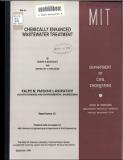Chemically Enhanced Wastewater Treatment
Author(s)
Morrissey, Shawn P.; Harleman, Donald R. F.
Download23741825.pdf (9.286Mb)
Metadata
Show full item recordAbstract
Many municipalities are currently under court order to provide secondary-level treatment to their wastewater. Since federal funding is no longer available to build the necessary facilities, the burden of paying for secondary treatment is on the rate-payers. Traditionally, conventional primary treatment followed by a biological process has been used to obtain secondary levels of treatment; however, the capital and operations and maintenance costs for this type of treatment are high. Chemically-enhanced wastewater treatment is a lower-cost alternative. Both jar and full-scale tests using chemicals and polymers have been conducted at South Essex Sewerage District (SESD) to determine the effects of chemically-enhanced wastewater treatment. SESD's plant is unique in that it can be run as two distinct, parallel, and simultaneous processes. This allowed a direct comparison between chemical treatment and conventional primary treatment. The test results indicate a significant improvement in the removal of total suspended solids, biochemical oxygen demand, phosphorus, and fats, oils, and greases without a large accumulation of sludge. The chemically-enhanced wastewater treatment process is extremely promising in terms of reducing the size of any additional treatment facilities needed to meet secondary levels, increasing the performance of overloaded clarifiers, and as a viable alternative to biological secondary treatment especially in environments where nutrient removal is more of a concern than BOD effluent concentrations (such as in the ocean).
Description
Supported by MIT's School of Engineering, the Dept. of Civil Engineering and the Ralph M. Parsons Foundation.
Date issued
1990-09Publisher
Cambridge, Mass. : Ralph M. Parsons Laboratory, Aquatic Science and Environmental Engineering, Massachusetts Institute of Technology, Dept. of Civil Engineering
Other identifiers
331
Series/Report no.
R (Massachusetts Institute of Technology. Department of Civil Engineering) ; 90-14.Report (Ralph M. Parsons Laboratory for Water Resources and Hydrodynamics) ; 331.